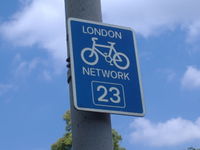Tag:route=bicycle
| Description |
|---|
| Cycle routes or bicycle route are named or numbered or otherwise signed routes. May go along roads, trails or dedicated cycle paths. |
| Group: routes |
| Used on these elements |
| Requires |
| Useful combination |
| Status: de facto |
| Tools for this tag |
|
Cycle routes or bicycle route are named or numbered or otherwise signed routes. They may go along roads, trails or dedicated cycle paths.
How to map
Bicycle routes are mapped in a relation ![]() of type=route.
of type=route.
In relations the following characteristics should be included:
- type=route mandatory
- route=bicycle mandatory
- network=* mandatory
- ref=* - Reference (number/code) of the route as signed by the operator
- name=* - Name (in full) of the route
- operator=* - operator
- network:type=node_network - When the route is part of a node network
Optional features
- distance=* - The distance covered by a route in km
- ascent=* - The ascent covered by a route in metres (meters). If a route has start and end points at different altitude, use descent=* too.
- descent=* - The descent covered by a route in metres (meters). Use it only if it differs from the ascent=*.
- from=*, to=* - name of the start and end location of the route
- roundtrip=yes - Indicate that the start and finish of the route are at the same location (circular route).
- signed_direction=yes - The route is to be cycled in only one direction, according to the signposts on the ground. This is more common with network=lcn routes. The ways within the relation should be ordered, as they are used to determine the direction of the signposts.[1]
- state=* - the current operational state of the route
Members
| Way/node | Role | Description |
|---|---|---|
| (blank) | The ways making up the route. | |
| forward/backward | If a route should be followed in only one direction for some or all of its length, the "role" can indicate this for some or all of the constituent ways. "forward" means the route follows this way only in the direction of the way, and "backward" means the route runs only against the direction of the way. Rendered on the cycle map (example). | |
| guidepost | A guidepost which refers the route. See information=guidepost. |
Split routes into sections
Since the international cycle routes contain many elements, it is common to divide them. You choose the areas so that the individual relations do not contain more than 500 elements. Suitable are political boundaries, but also names such as East and West. Afterwards the cuts are put together in a parent route of the type 'superroute' . This then contains only relations no paths.
The superroute has the same characteristics as the routes route=*, ref=*, network=*, name=*
Members of the Relation
| Way/node | Role | Description |
|---|---|---|
| (blank) | the route sections that belong together |
Roles
Most of the time, elements will be added with an empty role. For recreational route relations, a basic functional role set has been approved, see Roles_for_recreational_route_relations The approved roles are: main, alternative, approach, excursion, and connection. When no role is set, main is assumed. The roles are applicable to way members and relation members. Note that in relations containing ways with the directional roles backward and forward, the functional roles should not be used. As yet, there is no approved way to assign multiple roles to one element. In such cases, you can create a child relation for the variant and add it as a member with the appropriate role.
Cycling network
Sometimes it is desired to combine several routes into one network. To do this, create a Relation with the following properties:
Maps
Possible technical mistagging
|
The attribute route=bicycle tagged on node |
See also
- rcn_ref=* - The reference point for a regional cycle route.
Footnotes
- ↑ It's preferred not to use oneway=yes anymore, as it could cause confusion with oneway=* as a legal restriction. See discussion on tagging mailinglist.
